Workers on any jobsite require fall restraint solutions to limit their accessible area and fall arrest solutions to slow down and stop a worker in the event of a fall.
Lanyards are the crucial lifeline that are used in conjunction with an anchor and a body harness to create a complete fall protection system. The two most common types are a shock-absorbing and a self-retracting lanyard.
It is the responsibility of a site manager to ensure workers use the correct lanyards for different applications and this article will help you determine the most suitable and cost-effective solution for any job.
When it comes to fall protection systems, choosing the correct combination of systems to provide both fall restraint and fall arrest can significantly reduce the chances of a workplace incident.
For those working at height, lanyards are a crucial lifeline and the most effective method of arresting a fall. Self-retracting lanyards and shock-absorbing lanyards are both widely used connecting devices but they have very different characteristics that make each suited to different applications.
Understanding which to choose can be both a cost-effective and more secure solution for site workers.
What is a Self-Retracting Lanyard?
A self-retracting lanyard (SRL) is a vertical fall arrest lifeline that provides full freedom of movement for the user to undertake tasks.
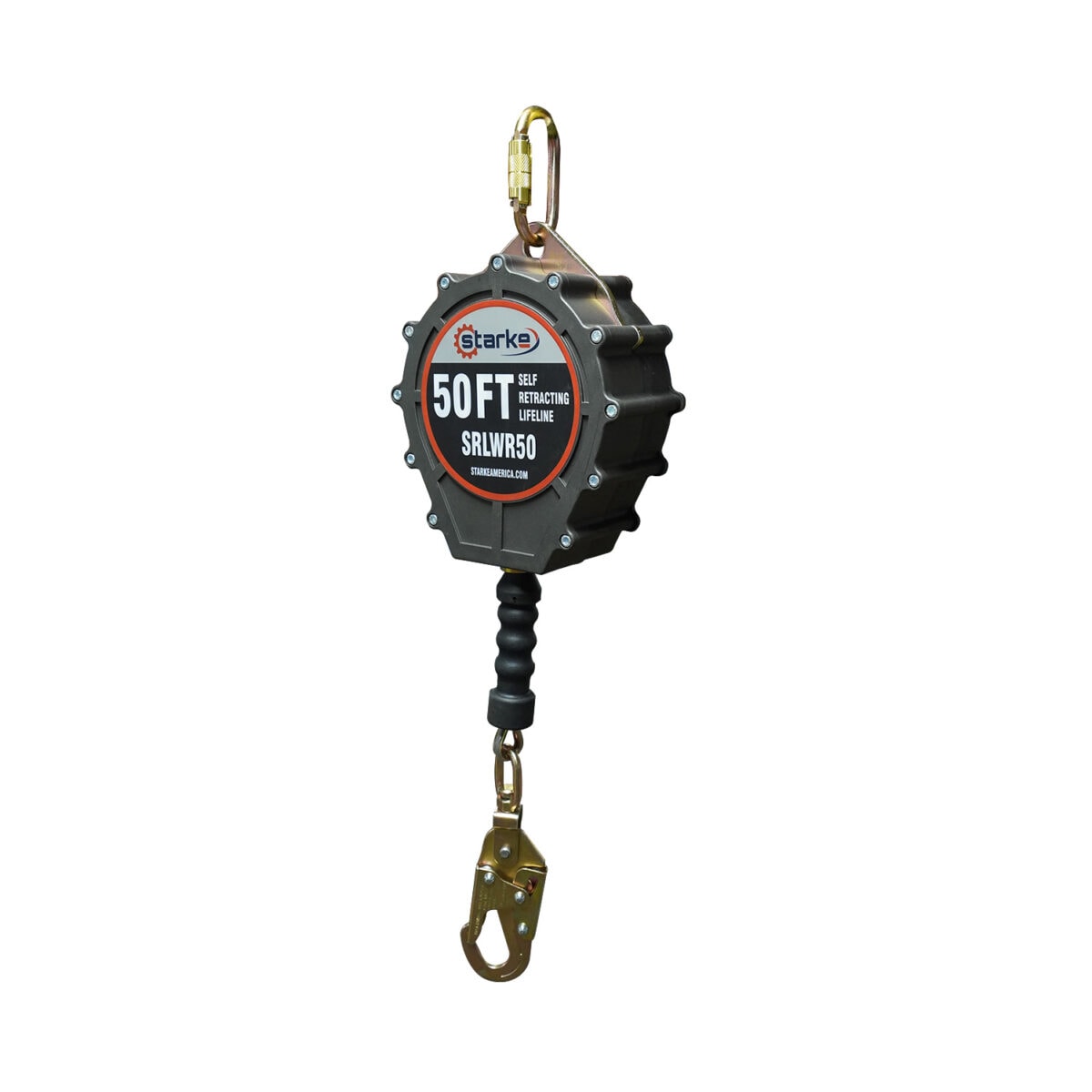
SRLs function a lot like a car seatbelt. The webbing or wire rope line is easily retracted to the maximum extension of 10 to 50 feet (depending on the model) and it remains under constant tension from the mechanism.
In the event of a fall, the rapid pulling force on the line will cause the internal braking mechanism to engage. It works by using an internal centrifugal clutch assembly with pawls that engage with the teeth of the brake hub, stopping more line from being released and arresting the fall.
What is a Shock Absorbing Lanyard?
It is a fixed-length fall restraint and arrest device that is attached to the user via a body harness. The other end is connected to an engineered fall protection system such as a trolley beam that extends out above the work area.
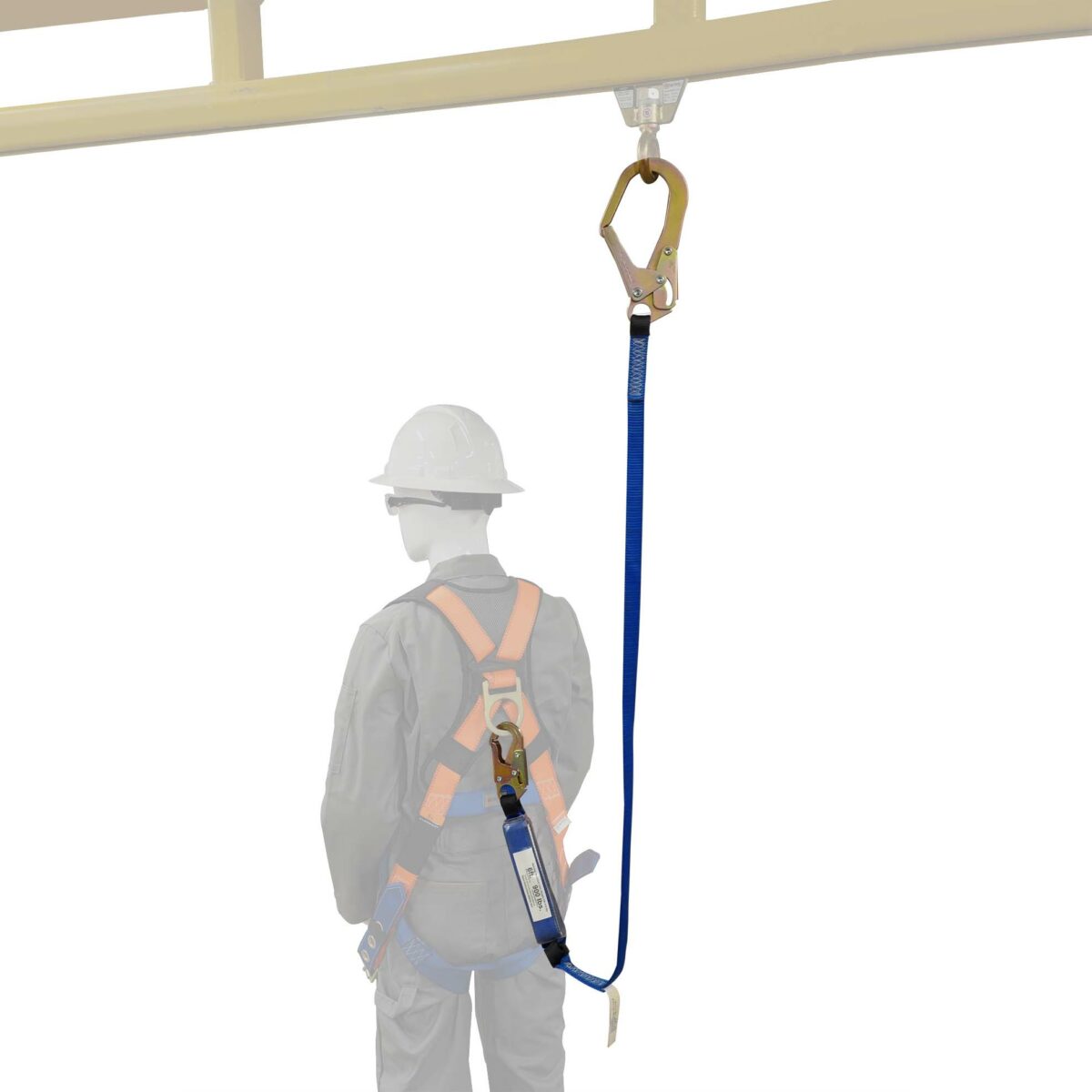
Shock-absorbing lanyards are typically six feet in length and include either a shock pack or are made with a shock-absorbing material (often nylon webbing). This can extend the length by three and a half feet to dissipate the jolt caused by a fall being arrested.
The six-foot length is designed to also limit the accessible area for the worker as an additional safety measure mitigating the risk of a fall.
Pros and Cons of an SRL
An SRL may appear to be the ultimate solution at face value, but it is important to acknowledge the pros and cons of the system before determining whether it is suitable for your requirements.
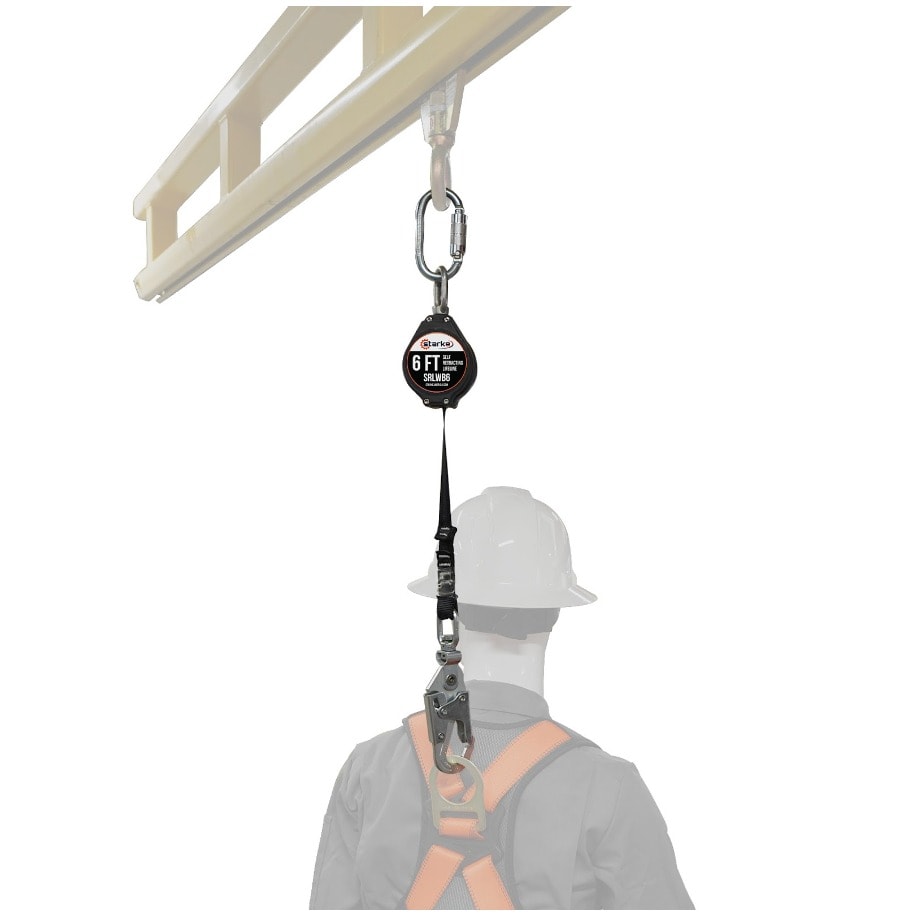
Pros
- The extendable line of an SRL remains under constant tension meaning that in the event of a fall, the worker will not experience freefall. It also reduces the total fall height making it suitable for tighter applications.
- SRLs are generally available in lengths of between 10 and 50 feet meaning that it is equally suited to jobs where space is highly limited as it is to accessing large distances.
- Larger heavy-duty SRLs are often equipped with a carrying handle that is suitable for use as a secondary anchoring point that is fall arrest rated.
Cons
- The SRL mechanism is bulky resulting in a comparatively heavier lanyard. This is particularly noticeable for long-length wire rope SRLs. The added weight and size can make it difficult to transport and maneuver which can make it unsuitable for some job applications where access is limited.
- Self-retracting lanyards are considerably more expensive than a standard shock-absorbing lanyards with costs ranging from $130 to $800.
- It is always advised to work on the plumb line from the anchor point when using any lanyard and the increased length of an SRL (up to 50 feet) increases the chances of a swing fall.
Pros and Cons of a Shock Absorbing Lanyard
Shock-absorbing lanyards are a deceptively simple device that has their advantages and disadvantages making them suitable to many, but not all situations.
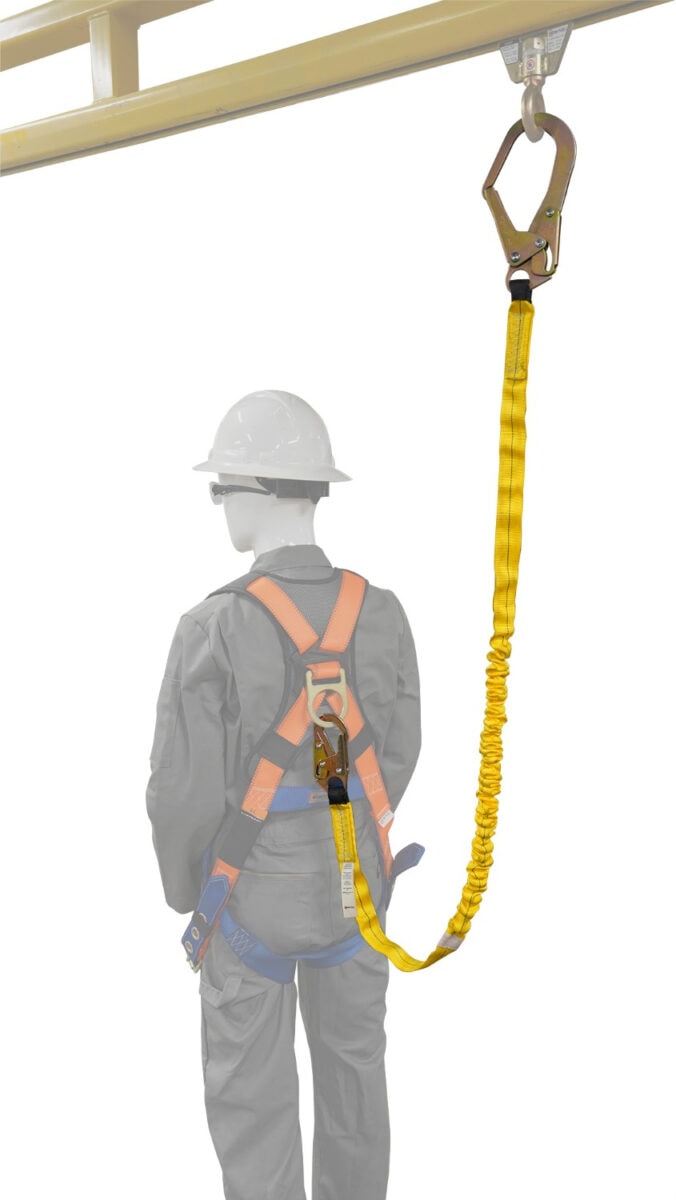
Pros
- They are lightweight and compact making them practical for use in situations where movement and access are limited.
- The inherently simple design means there are fewer things to go wrong.
- They are relatively inexpensive, typically ranging between $50 to $300.
Cons
- The fixed length may be too restrictive for certain job applications where a worker needs access to a large working area.
- The lanyard needs to reach its full extension before the shock-absorbing element can be activated meaning that a worker will experience freefall if they are working less than six feet away from the anchor point.
What Happens to a Lanyard After a Fall Arrest?
Both a shock absorbing lanyard and a self-retracting lanyard must be destroyed and disposed of after they have been impact loaded – in other words if either system has been used to arrest a fall, they are no longer deemed suitable for use again according to OSHA standard 1926 Subpart R Appendix G (d)(19).
The only way in which either system can be operated again is if they are inspected and considered suitable for reuse.
The use of a shock absorbing lanyard is visually clear, but a self-retracting lanyard may experience internal damage if they arrest a fall. Tampering or opening an SRL is not permitted therefore a certified technician must inspect the device and is able to make repairs that would permit it for use once again.
What is the Fall Distance of an SRL and a Shock Absorbing Lanyard?
The total fall distance of a shock-absorbing lanyard is significantly longer than the length of the lanyard itself, mainly because of the shock-absorbing element that increases the length by up to three and a half feet for a six-foot lanyard.
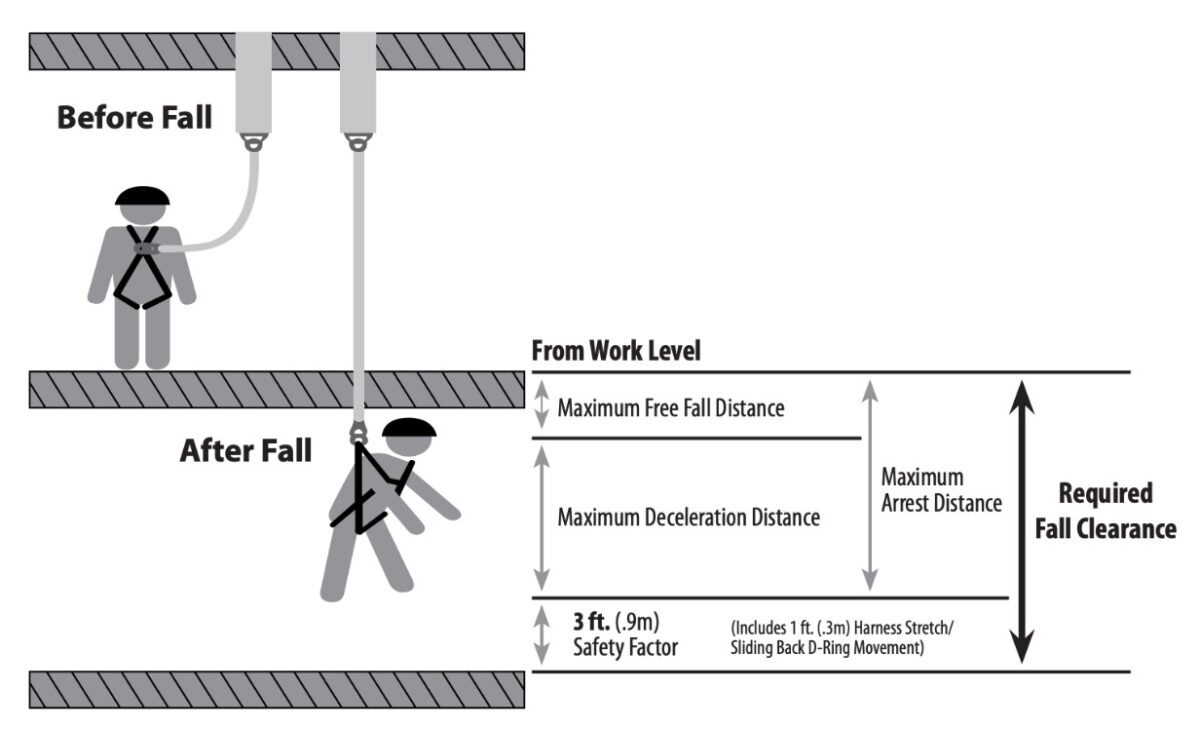
To understand the total fall distance of a shock-absorbing lanyard, we need to start with a length of nine and a half feet to account for the total extension of a lanyard. In addition to this, the worker’s height must be included. Six feet is considered the average worker height as per OSHA regulations. It also accounts for the lanyard-to-body mounting point which is usually at the shoulder of the body harness.
An additional three feet is added as a safety factor underneath the worker.
This then tells us that the anchoring point must be at least 18 ½ feet above the floor for a six-foot lanyard to provide sufficient fall arrest.
On the other hand, a self-retracting lanyard can arrest a fall from a significantly lower height because the wire remains under constant tension to prevent freefall.
The “average height” worker of six feet will be attached to the lanyard via a central mounting point of a body harness. The attachment point is central to help distribute the load better in the event of a fall because the rope has no elasticity.
Because there is little to no slack given in the line to aid in dissipating the shock of a fall arrest, and the mounting point is centered on a body harness to make up for the lack of shock absorption, the overall fall height is far lower.
This means that for an average height worker of six feet, the total fall clearance of an SRL is only six and a half feet.
Which Option Is Right For Me?
Both self-retracting and shock-absorbing lanyards have specific characteristics that make them better suited to different applications. While it can be argued that an SRL is applicable to more situations, there is no getting around the higher cost – although this is balanced by the fact that they can be reused after a fall.
Possibly the most important decision to make is whether the job application requires that a worker’s movement needs to be limited or not. If it is, a shock-absorbing lanyard is the only solution to provide fall restraint as well as arrest. These highly affordable lanyards can be stockpiled for use by entire teams of workers without a great investment or need for storage.
For most other applications, an SRL will provide a more flexible and adaptable fall arrest solution. Hoist Zone stocks both heavy-duty SRLs and lightweight SRLs in lengths of between 10 and 50 feet meaning that you will have no trouble finding the safest and most cost-effective solution for your worksite.
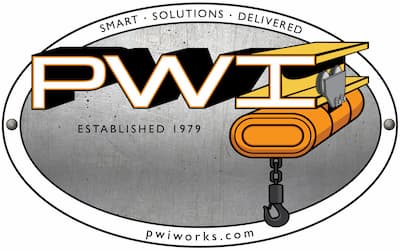

![New Construction vs Mezzanine [PDF]](https://pwiworks.com/wp-content/uploads/new-construction-vs-mezzanine-pdf-464x600.jpg)